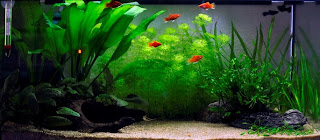Boas hoje trago-vos um artigo do site (Planet Inverts) sobre os camarões "Amano".
Introdução
O camarão Amano é muito popular no hobby. É o segundo mais popular depois do camarão Neo-Caridina "Red Cherry". O nome tem origem no bem conhecido aquariófilo Takashi Amano que usa frequentemente estes camarões nos seus aquários como comedores de algas. No entanto a maioria das pessoas desconhece que é uma espécie difícil de reproduzir e que a maior parte é apanhada no ambiente selvagem e vendidos aos aquariófilos. A reprodução em cativeiro é possível mas muito rara (é necessária ser feita em águas salobras). Tem um desempenho excelente em termos de limpeza do aquário.
Camarões Amano
(Nome Cientifico) Caridina multidentata
O camarão Amano é muito popular no hobby. É o segundo mais popular depois do camarão Neo-Caridina "Red Cherry". O nome tem origem no bem conhecido aquariófilo Takashi Amano que usa frequentemente estes camarões nos seus aquários como comedores de algas. No entanto a maioria das pessoas desconhece que é uma espécie difícil de reproduzir e que a maior parte é apanhada no ambiente selvagem e vendidos aos aquariófilos. A reprodução em cativeiro é possível mas muito rara (é necessária ser feita em águas salobras). Tem um desempenho excelente em termos de limpeza do aquário.
Popularidade
Como dito a cima para além da popularidade, com origem no aquariófilo Takashi Amano.
A maioria das lojas de peixes têm este tipo de camarão. Os aquariófilos por vezes iniciam-se com esta espécie devido à sua fácil aquisição. A noção de que é um comedor de algas soberbo atrais aqueles que têm aquários plantados. Infelizmente a maioria que adquire os mesmos não sabe que estes camarões não reproduzem em agua doce e perguntam-se porque as fêmeas mesmo com muitos ovos nunca produzem novas crias. (estes reproduzem apenas em aguas salobras e a determinada temperatura)
A maioria das lojas de peixes têm este tipo de camarão. Os aquariófilos por vezes iniciam-se com esta espécie devido à sua fácil aquisição. A noção de que é um comedor de algas soberbo atrais aqueles que têm aquários plantados. Infelizmente a maioria que adquire os mesmos não sabe que estes camarões não reproduzem em agua doce e perguntam-se porque as fêmeas mesmo com muitos ovos nunca produzem novas crias. (estes reproduzem apenas em aguas salobras e a determinada temperatura)
Deaths
It is not uncommon for the Amano Shrimp to die shortly after introduction to the aquarium. Virtually all Amano Shrimp are wild caught and are not used to captive conditions. Also, a lack of feeding can cause death as well. Most first timers keeping these shrimp think that they are solely algae eaters and can live off of the tank and require no food. You must feed this shrimp. Deaths are also caused by stress from shipping, handling, lack of acclimation to new conditions and from being introduced to multiple tank parameters. Remember that the Amano Shrimp is caught in the wild. It goes through a lot of stress during capture and during shipping around the world. Once it reaches the local fish stores it undergoes even more stress. When it ultimately ends up in the hobbyists tank it can be marked for death regardless of what the hobbyist does to keep it alive. Do not be surprised if this shrimp dies on you shortly after introduction.
Breeding
As stated before the Amano Shrimp requires brackish water in order to breed successfully. The pregnant females carry many eggs, most likely due to the loss rate of the larvae after hatching. The shrimp hatches as a tiny larvae free floating in the water. It is not like other shrimp which hatch as miniature adults. The larvae are very delicate and require special care. Below is a quick run down on information required to breed this species in captivity. It is a difficult task to captive breed the Amano Shrimp. However, if you are up for the challenge then good luck. It is definitely an achievement if you are successful!
Captive Breeding
The adults are kept in a 40 gallon 'breeder' tank with a sponge filter and lots of hornwort. The pH is close to neutral and the temperature around 75 degrees F. They eat 'GP Pellets' plus the occasional algae tablet -- there's also a lot of hair algae in the tank, more than they can keep up with.
Larvae are raised in full-strength (35 ppt) seawater that's pea-green with Tetraselmis algae. No supplemental foods are added. The latest batch was raised in a 2.5-gallon tank -- there was somewhat high mortality, so more space may've been helpful.
I've tried a variety of raising conditions. So far, the best results are with:
24-hour lighting
Gentle aeration
mid-70's Farenheit
In those conditions the larvae began metamorphosing into postlarvae after about 20 days. Higher temperatures seem to slow development. It took just about 6 months for a full life-cycle from hatching to egg production.
Feeding
It is recommended that the Amano Shrimp be fed like any other shrimp in the hobby. Using this species solely for the purpose of algae eating will not suffice in the long term for the shrimps health. These are rather large shrimp and require a good supply of food. They eat anything from blanched spinach, zucchini, algae wafers, shrimp pellets, fish flakes, bloodworms, and more. Feeding is best done once a day. Only feed an amount of food that the shrimp can finish within 2-3 hours maximum. It is not good to feed in excess and have food sitting for too long.
(by Planet Inverts)



